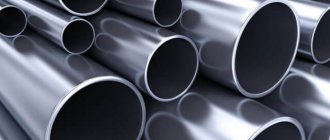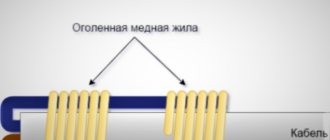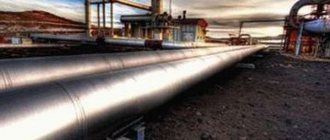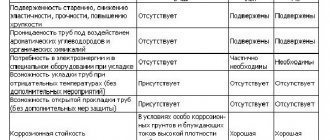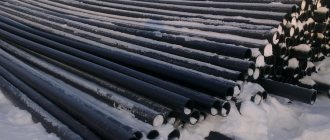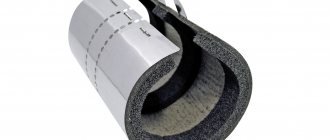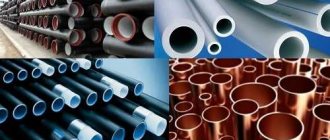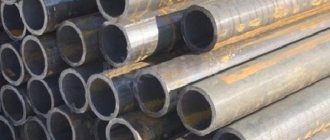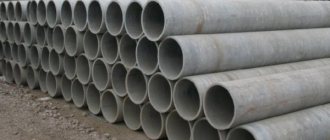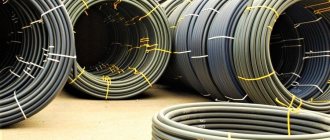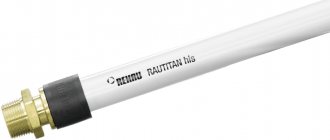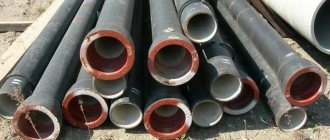Water delivery channels are among the most common utility facilities. Pipelines not only provide consumers’ domestic needs for cold and hot water, but also act as sources of liquid in industrial infrastructure. Moreover, there are no less significant communications through which oil and gas products are transported from the production site to processing plants. And in each case, the basis of such channels is the main pipeline. These are transmission lines of the target liquid or gaseous resource, connecting the source of production or content with the consumer.
Pipeline composition
The basis of the infrastructure is formed directly by metal pipes, but without plumbing shut-off valves their operation is impossible. Almost all water, gas and oil transportation lines have loopings and branches in different configurations, the design of which includes the inclusion of fittings, regulators and taps. At connection points to pumping stations, control and measuring instruments such as flow sensors and pressure gauges are usually installed. Accordingly, with their help, pressure indicators in the circuit and the volume of pumped resource are monitored. Cleaning agents are also common additions to main pipelines. The operation of canals supplying consumers with drinking water, for example, is accompanied by fine cleaning. For this purpose, filters with ionization and aeration effects are used. Industrial gas and oil refining networks also use condensate collectors and methanol injection units.
Gas line maintenance
Gas pipelines are regularly patrolled to detect problems or malfunctions in certain areas. After analyzing possible accidents or breakdowns, a plan of repair procedures is drawn up. Next, preparations are made for work with cleaning of the work area. The nature of the repair of the main gas pipeline depends on the location of the breakdown and its severity. The technical control service, in particular, can correct the position of shut-off valves, control and measuring devices and eliminate leaks in fasteners. Preventive repair and restoration procedures include replacing fences, painting structures, strengthening support blocks and restoring insulation contacts with dielectrics.
Main characteristics of pipes
Modern plastic pipeline structures are not used in main lines due to their low service life. As a rule, stainless steel sections are used, connected by electric welding or a spiral seam. SNiP section 2.05.06-85 notes that for channels up to 500 mm thick, pipes made of carbon steel should be used. As the diameter increases to 1020 mm, low-alloy mild alloys begin to be used. If we are talking about a thickness of more than 1400 mm, then the installation is made from elements whose metal is in a thermomechanically strengthened state. As the same SNiP indicates, main pipelines when connecting must also be maintained in terms of curvature. At each meter segment, the standard deviation does not exceed 1.5 mm. The total curvature should be within 0.2% of the entire channel length.
Why do they trust us?
- We have been working in the water supply industry for 15 years and know all the intricacies and nuances of water supply installation.
- The visit of the master and inspection of the site is free.
- We will do without the use of heavy equipment if you do not want to spoil the landscape design or damage the fruit and berry plantings.
- The price indicated in the estimate is final; we will not increase the total amount, even if difficulties arise during connection and additional work will have to be carried out.
- Interest-free installments for six months.
- The warranty on all types of work and installed equipment is 2 years.
- Payment is made only upon the fact that the water supply system is put into operation, no prepayment.
Order a free visit from a specialist and receive an accurate estimate on the day you contact us.
When you contact us, we can give you the estimated cost of all work and necessary materials. To find out the exact amount, an inspection of the site and the house is required. Examples of estimates drawn up from real practice.
Calculation of the water supply system on the site
Installation of water supply | |||
| Name | Unit. | Qty | Amount, rub. |
| Underground valve and rod 32 mm. (PND) | PC. | 1 | 16 000 |
| Carpet | PC. | 1 | 4 000 |
| Electric welded HDPE coupling 32 mm. | PC. | 2 | 1 000 |
| Tee nickel 1″ | PC. | 1 | 550 |
| Heating cable kit with gland | PC. | 1 | 5 500 |
| Ball valve 1″ | PC. | 1 | 1 100 |
Installation of a water supply system on site | |||
| Pipeline laying | m. | 6 | 6 000 |
| Piping inside the house (installation of a tee, cable line and tap) | PC. | 1 | 5 000 |
| Work on electric welding of couplings | PC. | 2 | 12 000 |
TOTAL | 46 150 | ||
Connecting to the main water supply takes only 1 day. But before that, we need to look at your site and make calculations. Call a professional right now - the sooner you take this step, the faster water will appear in the house.
Step 1
Order a free visit from a specialist: call or leave a request.
Step 2
Our engineer will arrive, the consultation will take 20-30 minutes. On the same day you will receive a final estimate of the cost of your plumbing.
Classification of backbone networks
Pipelines are divided according to the type of serviced resource, installation method and performance indicators. As for the first classification, the possibilities of using communications for transporting both liquid media (oil, water, oil, etc.) and gas mixtures have already been noted. In this case, for the second group, a division into classes according to pressure level is used: ranges 2.5-10 MPa and 1.2-2.5 MPa. At oil refineries, they use a classification based on the diameter of the main pipeline - this is a spectrum from 300 to 1200 mm, in which dividing boundaries can be distinguished at points of 500 and 1000 mm. With regard to the method of laying communications, above-ground and underground methods are usually considered. Accordingly, in one case, open installation with direct access to channel maintenance is assumed, and in the second, sealed pipe laying with complete backfilling and expectation of long-term operation.
Use of pipe types depending on installation method
In the case of underground installation, the resistance to soil corrosion and corrosion caused by stray currents is taken into account. The ring stiffness of pipes is important at high ground loads, for example in cities. Resistance to dynamic loads from the operation of vehicles and machinery - indicators that are relevant for laying highways in industrial areas.
In mining conditions, in seismically hazardous areas, in areas with possible ground subsidence, pipes are additionally protected with special equipment - compensators that increase deformation capacity. Such engineering solutions significantly affect the final cost of main pipelines. This is one of the main reasons for the increased use of polymer pipes. Their own ability to work deformation can significantly reduce the use of expansion joints.
When pipelines are installed openly, in addition to atmospheric corrosion, the service life is affected by exposure to ultraviolet radiation. The latter is especially true for some types of plastic pipes.
Features of offshore pipeline channels
This is also one of the methods for laying trunk networks for transporting gas and liquid resources, but it is used less frequently. The offshore pipeline is placed underwater after a comprehensive analysis of local water conditions. In particular, the preparation of the project is preceded by the determination of the speed of the bottom current, engineering-geological parameters, coastal topography and the ambient temperature in which the main pipeline will be located. The rules also define special requirements for ensuring protection. The external walls of the pipes must have thermal insulation, a concrete coating and cathodic anti-corrosion protection. Low-alloy and low-carbon steel structures are used as the main material for underwater channels. As a rule, electric-welded straight-seam or hot-rolled seamless pipes.
Types of transported substances
A fairly wide range of substances and media can be transported through main pipelines, among which are:
- Various types of natural gases;
- Hydrocarbon synthetic substances in gaseous state;
- Liquefied hydrocarbon gases;
- Oil;
- Various forms of petroleum products.
Transportation of each substance has its own technology. For example, oil is first accumulated in oil gathering points, and from there it is transferred to a processing plant.
Design of main canals
At the project creation stage, a set of technical documents is developed that describes design parameters, diagrams, drawings and a general plan for the construction of pipeline transport. A study of the area for laying a canal is also being carried out. Geodetic, geological and environmental conditions are assessed, as well as economic data justifying the project. The basis of the documentation is formed by information about the characteristics of the main pipeline - this can be information on throughput, pressure, number of transition stations and branches. Engineers also take into account the operational perspective of the infrastructure. The possibility of future modernization, reorientation or expansion of the network in accordance with new conditions of its use will depend on it.
Compressor stations
Compressor stations are needed to maintain pressure levels and transport the required volume of gas through the pipeline. There the gas undergoes purification from foreign substances, drying, increasing pressure and cooling. After undergoing processing, the gas under a certain pressure enters the gas pipeline.
Compressor stations, along with gas distribution stations and points, are part of the complex of above-ground structures of the main gas pipeline.
Compressor units are transported to the construction site in the form of blocks completely ready for assembly. They are being built at a distance of approximately 125 kilometers from each other.
The compressor complex includes:
Compressor station of main gas pipelines
- the station itself;
- repair and maintenance and service and maintenance units;
- the area where dust collectors are located;
- cooling tower;
- water container;
- oil farming;
- gas-cooled devices, etc.
A residential village is usually built next to the compression plant.
Such stations are considered a separate type of technogenic influence on the natural environment. Studies have shown that in the area of compressor installations, the concentration of nitrogen oxide in the air exceeds the maximum permissible level.
They are also a powerful source of noise. Scientists have found that prolonged exposure to noise from a compressor station causes disturbances in the human body, and, as a result, causes various diseases and can lead to disability. In addition, noise forces animals and birds to move to new habitats, which leads to their overcrowding and a decrease in the productivity of hunting grounds.
Safety system installation unit
Laying main pipes
The construction of the pipeline is carried out in accordance with the technical solutions adopted in the project, taking into account the specific installation conditions. As a rule, laying is carried out using earth embankments or supports acting as a load-bearing base or foundation. Moreover, in one technological corridor of the network, pipes for different purposes can be laid simultaneously - this is how combined or adjacent routes are formed. The minimum depth level for the construction of main pipelines is 80 cm for diameters less than 1000 mm and 100 cm for channels with a thickness of more than 1000 mm. The depth of occurrence increases on unstable soils if the support base is laid on irrigated or arable lands.
Construction technology
The construction is carried out in several stages. Based on the project, earthworks, installation operations, laying and backfilling activities are carried out. First, a trench 50-150 cm deep is formed. The bottom is backfilled with drainage layers of sand and crushed stone, after which support blocks based on concrete or metal are installed. On this basis, the direct construction of main gas pipelines is subsequently carried out using welding to connect individual segments. After installation is completed and the quality of the force fixation is checked, the line is backfilled.
Pipeline protection means
The basic requirements for insulation are determined by the need to prevent corrosion processes. The protective shell must provide dielectric properties, and also be continuous, waterproof and durable. These requirements can be met by special paint and varnish compositions, polyvinyl chloride and polyethylene coatings, bitumen and silicon mastics. Depending on the characteristics of the seismic zone, a special construction of embankments may be required that will prevent the impact of ground movements on the main pipeline - SP number 14.13330 of 2011, in particular, indicates the need to relieve stress through loose sand embankments, sandy loams and loams. During operation, such a base will act as a damper cushion, minimizing vibrations and vibrations.
Network Maintenance
Already in the design documentation there should be a schedule for the implementation of preventive measures aimed at maintaining the optimal technical condition of the pipeline. The maintenance team checks the tightness of the circuit, the condition of the connecting nodes, measuring equipment and transition stations. Also, at the stage of putting the infrastructure into operation, a protection zone for main pipelines is established, in which excavation works, the laying of other transport networks, construction activities, etc. are prohibited. The range of this territory around the canal is on average 25-100 m.
Selecting the optimal set of earthmoving and transport machines
2.1 Selection of dump trucks for sand delivery
The volume of sand in a dense body in the bucket of the Amkodor 352 quarry loader is calculated by the formula:
,
where Vkov is the accepted volume of the loader bucket, (2.8 m3); Knap - bucket filling coefficient (0.8); Kpr is the coefficient of initial loosening of sand (1.17).
Mass of sand in the loader bucket:
,
where is the density of the soil in its natural occurrence, t/m3.
Number of buckets of soil loaded into the body of a dump truck:
For a transportation range of 17 km, we choose a KamAZ-65115 dump truck with a carrying capacity of 15 tons.
Rice. 6. Appearance of the KamAZ-65115 dump truck
Determine the number of loader buckets required to load the dump truck:
ladle.
Volume of sand in a dense body loaded into the body of a dump truck:
